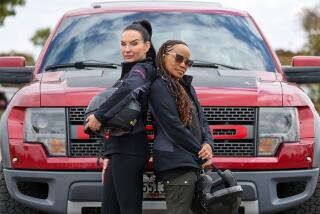Ladies Day at Daytona : Bill Venturini Uses an All-Female Crew
- Share via
Over the loudspeaker at Daytona International Speedway came the announcement:
“Bill Venturini, first driver in ARCA history to better 200 m.p.h. at Daytona. Listen to this! Two hundred one point seven four six miles per hour.”
At that moment, 10 women, all clad in blue slacks and white monogrammed shirts, screamed as one, punched fists into the air and started running down pit road toward the garage area.
It was not an unusual sight, crews running to a winning stock car, but women? It’s not that many years since women were not allowed in a garage area for any reason, as reporters, publicists, wives or girlfriends--even to light a cigarette for a favorite driver.
Now Bill Venturini was there with an all-woman crew--the Permatex Ultra Blue Crew. And with a fast car.
The crew, directed by Bill’s wife, Cathy, goes with Venturini and his Chevy Monte Carlo to all Automobile Racing Club of America races and handles all race day chores during pit stops.
“It started as a publicity stunt, but when it turned out the girls did a good job, as good as any crew in the pits today, we decided to stick with them,” Venturini said.
“I’m here to win, and if they weren’t getting the job done, I’d get someone else.”
Venturini, who runs two Amoco (coincidentally, his car sponsor) gas stations in Chicago, finished second to Scott Stovall of Fort Wayne, Ind., in the Daytona ARCA 200.
Changing tires and refueling a 3,400-pound stock car during a race is not the same as doing it at your neighborhood self-serve station. It has become a high-speed ballet during which tires are changed and tanks refueled in seconds.
It’s no job for women with long fingernails.
Tires, which must be hoisted over a three-foot cement wall to be mounted on the car, weigh 75 pounds each. An 11-gallon can of gasoline weighs nearly 70 pounds and two of them are needed for each pit stop.
“We have 16 girls that we rotate from race to race,” said Cathy Venturini, who recruits, trains and directs the crew. “We like them tall and strong, but we have all types. The most important thing is that they like to work. It’s a difficult job, but it’s exciting, and it’s different.”
Cathy is the team’s No. 1 tire changer, a job she handled in the years before there was an all-woman crew.
“I’ve been around the longest,” Cathy said. “The other girls call me the old lady.”
Her sister, Carol Tortorice, a 16-year-old high school senior from Wauconda, Ill., is the other tire changer.
Della Dielarz, a secretary, and Elaine Jones, a model and part-time waitress, are the tire carriers.
The gas cans are handled by Mary Burau, assistant manager for a Jewel food store, and Rae Caffarello, a hospital scrub nurse.
“The women don’t do any mechanical work on the car,” Venturini said. “That’s all done by Norman Negre. His dad (Ed) used to drive Winston Cup cars.”
This is the second full season Venturini has used an all-woman crew.
“We first did it as a publicity stunt back in 1982 but couldn’t afford the luxury,” his wife said. “We had given up the idea when Bill was at Talladega in 1985 and was introduced as the guy who once had an all-girl crew. Sports Illustrated used an item about it and that led to Permatex deciding to sponsor them.”
Venturini advertised in racing publications for candidates, but received no replies, so he and Cathy started calling friends and customers. Venturini also put up posters around the neighborhood.
“Once we found enough for a crew, word of mouth became our best recruiter,” Cathy said. “We have tapes of what we do to show new girls. If they’re still interested, we have them work in one of our practice sessions.”
The crew practices during the off-season and also works out several times before each race at Venturini’s garage in Chicago.
“The toughest part of my job is deciding who’s available and who’s going,” Cathy said. “We have 16 girls on the team and we need a minimum of eight at each race.”
The women receive no pay, but get their expenses paid, including lodging, food, travel and incidentals. For a major race, such as Daytona, it can mean 10 days away from home and jobs.
All of them dress identically in blue slacks, white shirts, white gloves and, when it’s chilly, blue and white sweat shirts.
Sherry Bowlek joined the crew this season. Her first duty was to handle the pit board.
“I saw one of the posters in my neighborhood and thought, ‘Boy, that sounds like fun,’ so I signed up,” she said. “After Cathy showed me the tapes, I knew I wanted to try it. It was really exciting, standing out there on the track with my board, waiting for Bill to come in.”
Sherry’s board told Venturini where the No. 25 car was to stop. The Chevy was still slowing when Cathy and her sister were over the wall, air wrenches in hand. Della and Elaine came after them, arms full of 22-inch tires, along with Bonnie Barendse, a homemaker who was handling the jack.
Barendse slid the jack beneath the car. In less than 15 seconds the tires were changed and Barendse dropped the Chevy and pulled the jack away. The windshield had been cleaned and Venturini handed a cup of water. As the car hit the pavement, Cathy Venturini signaled Bill away. The car gunned out of the pits, but before the women could relax they were preparing for the next stop--getting the old tires away, new tires in position, and filling the 11-gallon cans with gasoline.
Sometimes, though, it doesn’t happen quite like that.
In a recent race at Atlanta, Venturini ran out of gas after a mix-up during his final pit stop.
“We had an inexperienced girl handling one of the gas cans and she slipped coming over the wall,” Cathy said. “Mary (Burau) had the second can, so she saw what was happening and emptied hers first. The trouble was, when she pulled her can away, everyone thought it was the second can and we dropped the jack.”
That was the signal for Venturini to roar out of the pits--without enough fuel to finish. When he ran out, he coasted across the finish line in fifth place.
Venturini came back from that disappointment by winning the last three ARCA races, including last Sunday’s at Rockford, Ill., and has taken the standings lead from Grant Adcox of Chattanooga, Tenn.
Since 1983, when Venturini was named rookie of the year after finishing second to Bob Dotter of Chicago, he has finished second in the standings twice more, in 1984 to Dotter, again, and in 1985 to Lee Raymond of Dayton, Ohio, and third last year, behind Raymond and Dotter.
“One of these years, with the girls’ help, we’ll win this thing,” Venturini said.
More to Read
Go beyond the scoreboard
Get the latest on L.A.'s teams in the daily Sports Report newsletter.
You may occasionally receive promotional content from the Los Angeles Times.










